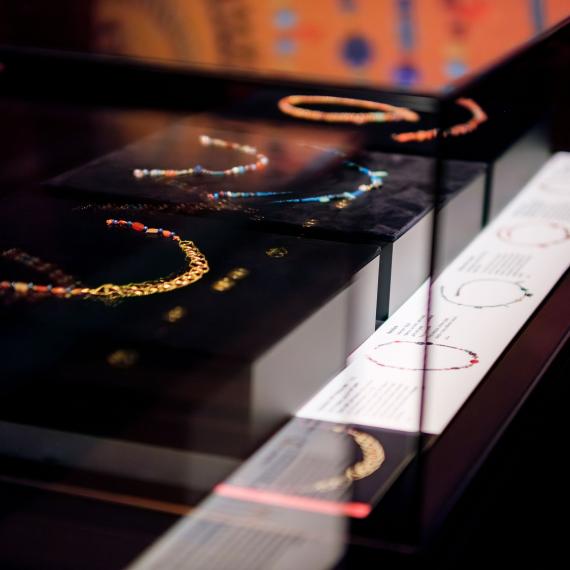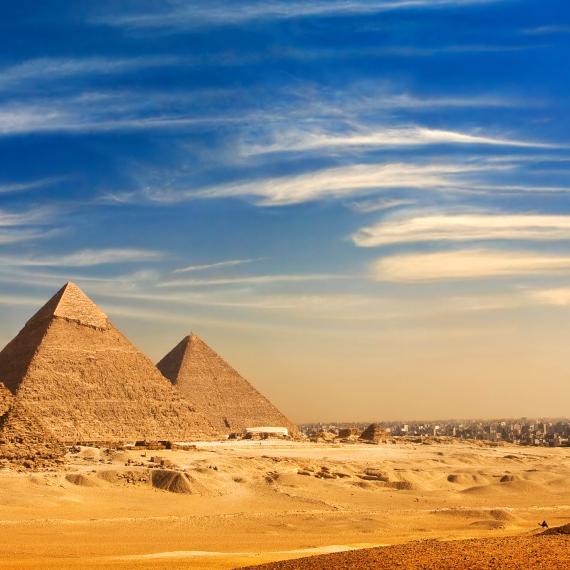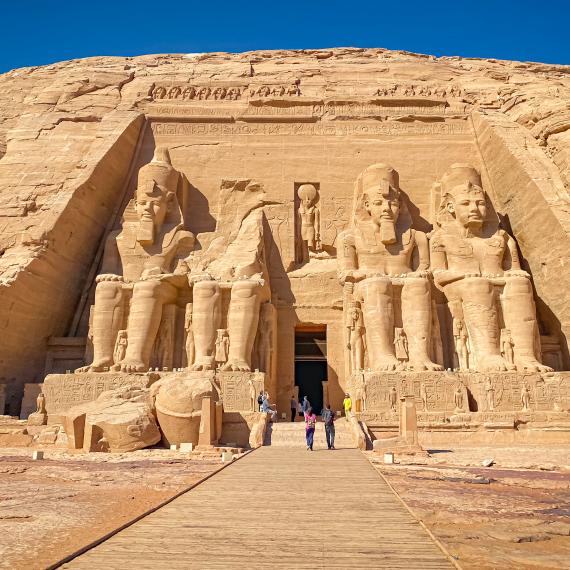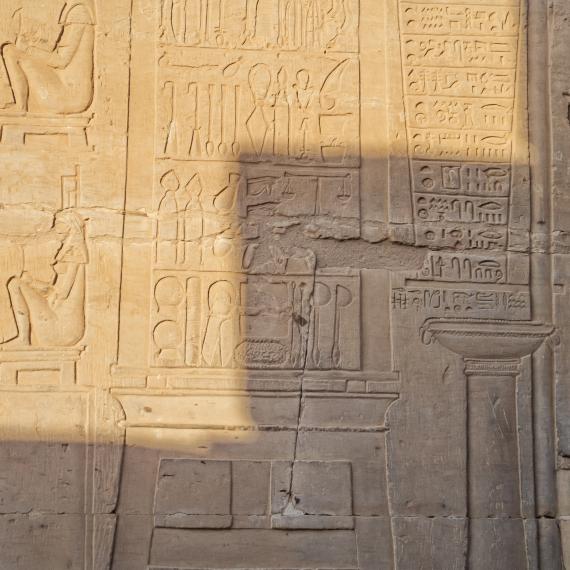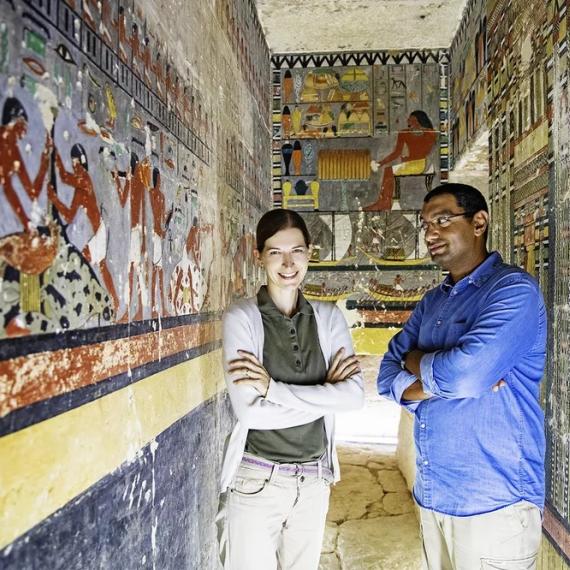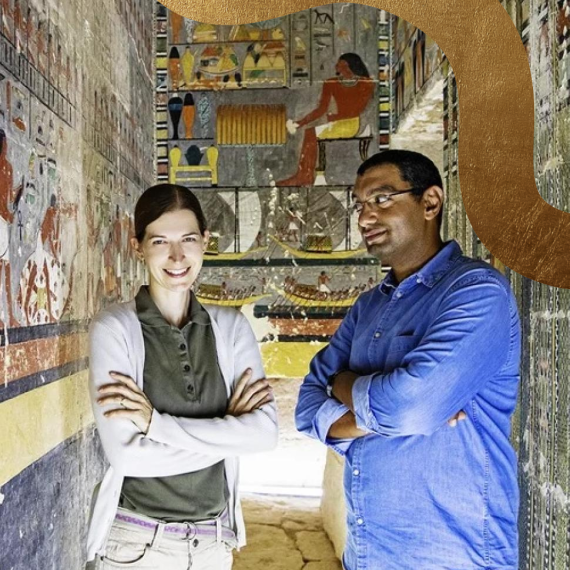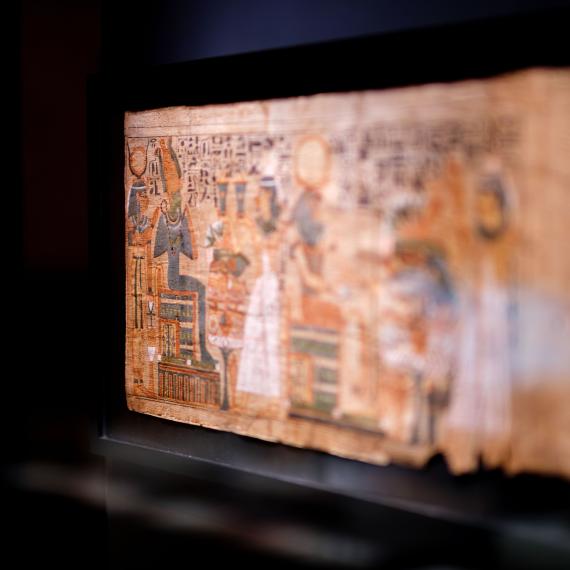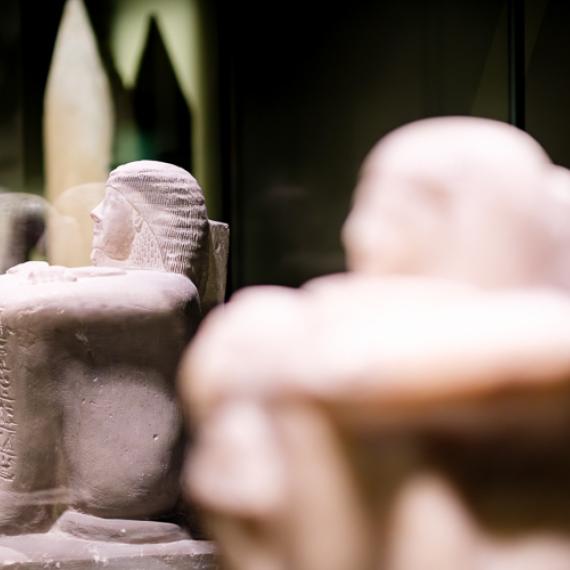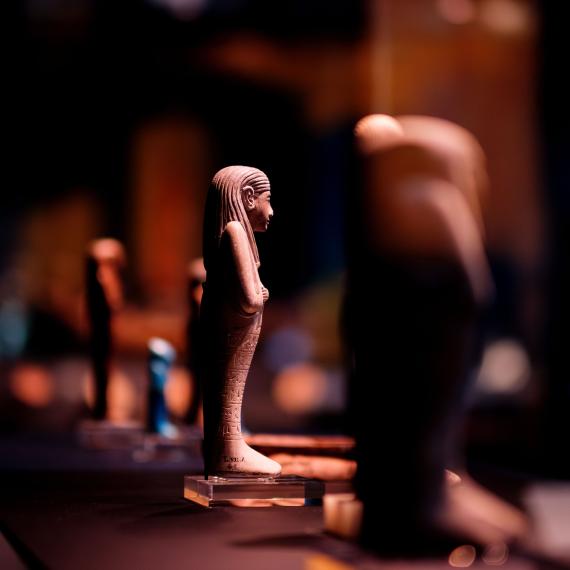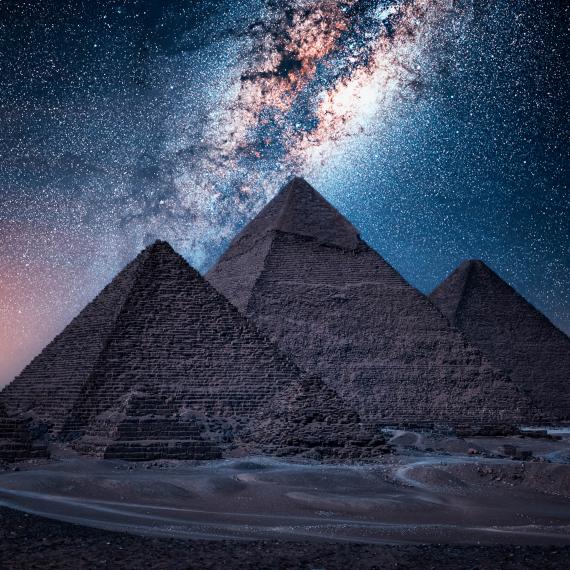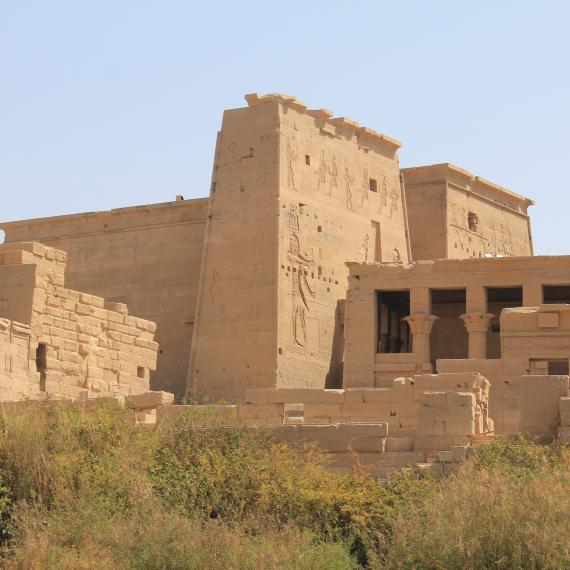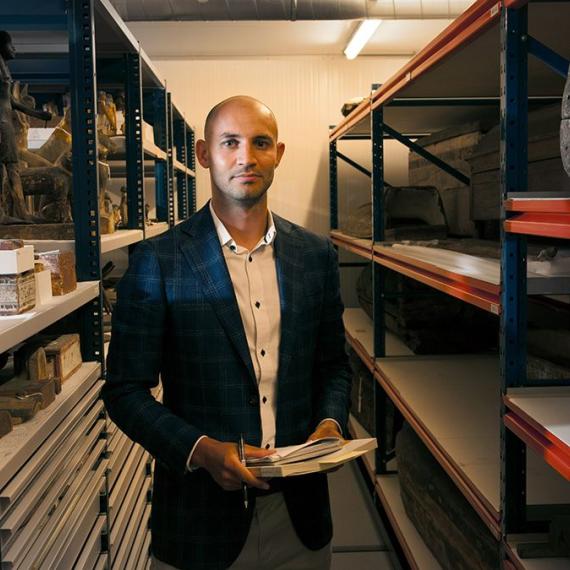
Mechanisms of the Cosmos by Dr Amelia Fraser-McKelvie
Celestial Timekeeping in Ancient Egypt - Discover how Ancient Egyptians used the heliacal rising and setting of stars to construct their star clocks and civil calendar. Dr Amelia Fraser-McKelvie is an astrophysicist working at the International Centre for Radio Astronomy Research and a night sky tour volunteer at the Perth Observatory. Her research focuses on the formation and evolution of galaxies, with a particular interest in galaxies that look like our own Milky Way.”
-
Episode transcript
Intro:
Welcome to the Western Australian Museum Boola Bardip talks archive. The WA Museum Boola Bardip hosts a series of thought provoking talks and conversations, tackling big issues, questions and ideas and is delighted to be able to share this with you through the talks archive. The talks archive is recorded on Whadjuk Nyoongar Boodja. The Western Australian Museum acknowledges and respects the traditional owners of their ancestral lands, waters and skies.
Event MC:
Good evening everybody and welcome to the WA Museum Boola Bardip and the Discovering Ancient Egypt Exhibition. Before we get started with our guest speaker for this evening, I would just like to take a moment to acknowledge the lands on which we are gathered on and learning here today, the lands of the Whadjuk people of the Nyoongar nation. And may we continue to pay our respects to their elders past and present.
This evening we have a fabulous guest speaker, Dr. Amelia Fraser McElwee, who will be delivering a presentation about how the ancient Egyptians told the date and time through the stars. Please make them feel welcome.
Dr Amelia Fraser-McKelvie:
Hello, everyone. Thank you so much for coming. Yes, My name is Dr Amelia. I'm an astrophysicist. I work at the University of Western Australia. Not an Egyptologist, an astrophysicist, and I also volunteer my time up at the Perth Observatory, showing the public, just like yourselves, the night sky. So that is who this presentation is in conjunction with tonight and I had some help from my friends at the observatory, Lexi, Arthur and Steve. So thank you to them. So I'm going to be talking to you tonight about how the Egyptians told the time and the date through just the stars in the night sky.
Now, to start off with this beautiful image, it is very obvious that the night sky was very special and very important to the ancient Egyptians. They had a lot of stories and a lot of mythology surrounding it. This here is the sky goddess Nut. You can see she's stretched over the night sky. She was often depicted this way with her hands and her feet touching the Earth at the four cardinal points. Now, they said that every night Nut swallowed the Sun and it passed through her body during darkness and then in the morning it was rebirthed by her. So very clear that there was a lot of relevance of the night sky in ancient Egyptian culture.
So let's take a tour back in time 5000 years ago. Let's imagine we are in ancient Egypt and we look up at the night sky. What do we see? Well, the night sky would have looked fairly similar to this image here. This is actually the night sky over the Perth Observatory up in Bickley. But not much has changed in 5000 years. Okay, maybe there's a few fewer StarLink satellites and we've got now. But apart from that, the night sky would have looked very similar, both for the ancient Egyptians and of course the indigenous Whadjuk Nyoongar people here in Perth. They would have seen much the same when they looked up into the night sky. So I think probably the first thing that the ancient Egyptians would have noticed would have been the stars in the night sky. They would have seen hundreds, if not thousands of bright stars. Some of these stars were very special in that they were always up.
So no matter what time of the night, what time of the year you looked up, you saw your favourite star. These days we call these stars circumpolar, which means they are always up in the night sky. We have our own circumpolar stars down here in Perth. You might know of one of my favourite constellations, the Southern Cross. On the flag, Australia's flag obviously tattooed onto the chest of several people in this audience, I have no doubt. Southern Cross is circumpolar. It is no matter what time of the night you look up in Perth, you will always see our friend, The Southern Cross. So Egypt had their own circumpolar stars. But over in the northern side of the hemisphere. Umm, these are very important, they had a lot of ceremonial importance, including the way that the pyramids were built and things like that. So these were the circumpolar stars. There were also stars that rose and set over nighttime as well. Now, the brightest star in the night sky then and now is Sirius, or Sopdet as it was called, by the Egyptians, or Sothis by the ancient Greeks. Sirius was a important star. And in fact, that's the goddess associated, Sopdet and it rose and it set in the Egyptian night sky.
Other things that the Egyptians might have seen in the night sky. Well, the Moon. The Moon, of course, ever present, umm, and the phases changing. So the Moon God, Thoth, was associated with the Moon. The Egyptians would have noticed that the Moon became brighter, so became full and then started waning again half and then to New Moon and back again. On a cycle, it took roughly twenty-eight, twenty-nine days, something like that. And they would have noticed the regularity. And in fact, one of the first Egyptian calendars was based on the Moon. Umm, Now the lunar cycle happens roughly once per month, but 12 lunar cycles does not equal one full rotation of the Earth around the Sun. So one year. So actually this was fairly inaccurate and they got rid of that one pretty quickly. Still, though, the Moon, very important in ancient Egyptian mythology. The other thing that they would have seen when they looked up into the night sky was some really, really bright stars that followed the same line across the sky as the Sun and the Moon. We call this plane now the ecliptic and these bright stars would have been a little bit confusing because they didn't follow the same path night after night as the other fainter background stars.
We know that now that these are the planets and the reason that the planets were moving in a different direction, at least to the background stars, is because of the motion of the planets around the Sun. So here is our friend, the solar system. Sun in the centre. We've got a four in a planets Mercury, Venus, Earth, Mars, the asteroid belt, and then our four gas giants. Now, when I was going through school, Pluto was still a planet. So you had a different mnemonic to remember the planets. But this was my favourite one that I found on the Internet this week: "My Very Educated Mother Just Served Us Nachos”. If you can remember that mnemonic, you can remember the order of the planets and impress, any five-year-old, you know.
Audience:
*laughs*
Dr Amelia Fraser-McKelvie:
So you can see from this, of course, that the planets orbiting the Sun. So it was a motion of the planets around the Sun with respect to our own motion around the Sun, which meant that they kind of wandered around in the sky. Now this is useful. This, I think, is a slightly better way of visualizing the solar system. This is a scale that big old yellow thing is obviously a Sun. It's so big compared to all of the other planets too. The Earth is a third one from the left there, that tiny little dot just for scale. And of course, the ancient Egyptians attached a lot of weight to the Sun as well. It was always there and we had the Sun god Ra, which was one of the most important gods. The Sun god used to carry the Sun across the sky in his little raft and then at Sunset he descended into the subterranean underworld following the Nile, and he had some trials and tribulations. He had to get through twelve of them, in fact and if you passed all of those trials and tribulations which he’d seem to do every day without fail, he would rise again in the morning and the Sun would come back up.
So this is the solar system. Now, the ancient Egyptians, of course, wouldn't have known that the Earth is rotating around the Sun. But we do now. Now, the final thing that I think the Egyptians would have seen in the night sky would have been the Milky Way. So our view is down there on the bottom right, this beautiful strip of stars, gas and dust stretching across the night sky called the Milky Way, because there is just so many stars in there, a hundred billion to be exact or exact-ish, so many stars that the starlight blends all together and it looks milky in appearance.
And in fact, the Egyptians saw that, too. They considered the Milky Way to be a pool of cows, blood, sorry, milk, cows milk.
Audience:
*laughs*
Dr Amelia Fraser-McKelvie:
*laughs* I don't know. After some red wine, clearly. So the Milky Way is a disk galaxy okay. Bit hard to see from our view, but it looks something like this from the outside. It's a rotating disk or pizza or frisbee, whatever you prefer, your favourite rotating object. And that big “You Are Here” sign, that's exactly where we are. And the Sun. Now, this image is a little bit deceptive in that it looks like the kind of halfway out, but actually most of the matter in the Milky Way is inside the Sun's radius there. There's not a lot on the other side. We are embedded within the disk of our galaxy. And so that's why when we look up, we see this thin strip. We're looking into the centre of our own galaxy. To give you an idea of some of the scale, there's a little thing saying it's 100,000 light years across, one light year being the distance that light travels in a year. Now for a bit of scale, this is the Voyager probe, Voyager one. This was launched in the seventies, and this is the furthest object away from Earth. It is also one of the fastest moving objects that humans have ever created. This particular probe is traveling currently at 60,000 kilometres an hour, pretty fast or seventeen kilometres per second, if you prefer that. And so fifty kilometres, sorry, fifty years, 60,000 kilometres an hour, twenty-four billion kilometres away. Right now, the furthest we've ever travelled. It's left the solar system. It's in interstellar space. So where is Voyager in this picture? Right there ok.
Audience:
*laughs*
Dr Amelia Fraser-McKelvie:
I think it's 0.002 of a light years away from us. Okay. So these are the scales involved. That is our Milky Way. So coming back to our image of the night sky, what about if we were to look at a dark patch of sky where there's no stars? Is that empty? Well, no. It's full of other galaxies just like our own. Another hundred million or so, or maybe even two trillion. If you're listening to the James Webb's results coming out these days. So there is just billions upon trillions of galaxies in our night sky. And each one of those probably has billions of stars. So just thinking about the almost infinite possibilities of different civilizations and how they might have viewed the stars around them compared to how the same species just 5000 years apart feed our own night sky, umm, is interesting, but maybe a little bit existential for this time on a Friday.
So let's move swiftly on back to science and the Egyptians, of course, the topic of this talk. So why was it important for the Egyptians to measure the time of the year and even the time of night? Why? Why did they need to know? Well, it was all about harvest, all about agriculture, folks. The Egyptians divided up their year into three seasons. The first one was called Akhet. This is called the inundation period. So of course we know Egypt is a bit of a desert, but flowing through it is the Nile. The Nile is really the lifeblood of Egypt. And once a year it floods. Okay. So you want to know when that's happening so you can get out the way. But more importantly, after these one hundred and twenty days, we move into the next season. Peret. Now, Peret is the heart of the planting season. So once these flood waters recede, you've got lots of fertile soil that you can be planting in. So you need to know when to do your planting. And then finally, the third season is, Shemu, the harvest season. You need to know when to harvest all of your crops. So each of these three seasons were a hundred and twenty days long each. Now, who of us in the audience is good at quick maths? What's three times one hundred and twenty? Three hundred and sixty, exactly right, I hope that’s what I heard. Now, that's still not a year, is it? It's still not quite close. And the ancient Egyptians knew that.
They knew they were short of a year, so they added five extra days. At the end they called epagonome… hmmm I got epaga…. hmm Come on, epagomenal days. Got it! Epagomenal days, these five extra days. and actually, they were related to the gods, the, the children of Nut, the sky goddess. Her sons and daughters had a day each. And so five days of party, party, party celebrating the gods. So you add that to your 360 days and you get pretty close to a full rotation of the Earth around the Sun, close to one year. Hey. Now, each of these three seasons divided into four months, four months had thirty days each. Sounds pretty legit so far, but then they further divided the month into three, ten day weeks, which we somewhat confusingly we call decades.
Okay, so this is the year according to ancient Egypt, and that's great. But how, how did they know? How did they know a new year was beginning? Well, that is through the stars. So the ancient Egyptians made an observation. They realized at s… they looked to the east, at Sunrise. Now everything rises in the east and sets in the west folks. They looked over to the east just before the Sun was about to rise, and they saw their favourite star, Sirius. Sirius was also just rising. Now, when a star rises, just before Sunrise, it's got a special term. We call it a heliacal rise, that's going to become important later. But the Egyptians observed that this heliacal rising of Sirius often happened just at the same time that the Nile was flooding.
And so that's when they decided to start the year. They said, okay, when we observe that Sirius is rising just before Sunrise, we call that the start of our year, the start of inundation season. And so from this observation, we know that the Egyptians could use the stars to tell the dates and the times. That's pretty cool. But one slightly complicated factor, what they also observed is that Sirius wasn't always on the horizon at Sunrise. The first time they observed it, yes, they came back the next night and it was actually one degree higher in the sky and actually rose four minutes earlier and earlier and earlier and earlier. And if you kept looking to the east just before the Sun rose, you'd see that Sirius is getting higher and higher and higher and higher in the sky. All the way over until eventually it sets in the west before the Sun rises. And then Sirius disappeared for seventy days. Why seventy? Well, I don't know. But an interesting um, coincidence maybe, is that this is the same amount of time that the Egyptians embalmed their dead for. There you go. So they definitely knew that the stars were moving with time. And this is a nice little animation that shows you what's happening here. You can see Sirius over to the right, our favourite star, and you can see it moving through the night sky. First of all, over one evening, you can see and the morning after as well. You can see it moving across the sky. And we're going back in time now. Now, instead, you can look at the exact same time of night, but different days now. And you can see each day at the same time, Sirius is slightly higher and higher and higher in the sky right? So this is the movement of these background stars here on Earth. Now, the Egyptians wouldn't have known what caused this, but we do, and I'm an astronomer, so I can explain it. It's all to do with the movement of the Earth around the Sun. Now, folks, this is the point in time where we have a little bit of a demonstration.
So what have I got for you? I've got some background stars. There we go.
Audience:
*laughs*
Dr Amelia Fraser-McKelvie:
Call that Sirius. Can I steal this microphone? Thank you very much. Folks, I'm going to need a volunteer who's filling Sunny today? Up the back. Yes, I like you've got a yellow jacket on. Come on down. You can be our Sun. Our Sun is for sale in the Perth Observatory gift shop for $34.95 by the way.
Audience:
*laughs*
Dr Amelia Fraser-McKelvie:
I’ll give you the Sun. Now I've got to turn you on.
Audience member:
Alright *laughs*
Dr Amelia Fraser-McKelvie:
There we go. There's a Sun. Now I'm going to get you to stand right here for me. Perfect. You're in line. And we've got some background stars. We’re going to call Sirius. We've got the Sun, and here we have the Earth. Now, I will stress that this is not to scale. So the Earth rotates on its axis once a day, right? That's one day. It also orbits around the Sun. Sorry, I'm going to steal some of your dinner in a second. Orbits once around, around once a year. Okay, So let's find ancient Egypt, Africa. Here it is. Now, when the Sun is in… the Earth and the Sun are in this position, okay, It's nighttime in Africa because it's facing away from the Sun. When I rotate, it's daytime, Right? With me so far? So nighttime in ancient Egypt now let's have a look at what stars are visible. Are the background stars and Sirius visible here now? No, exactly right. Because the Sun is in the way. It's daytime there, right? So we can't see Sirius when the Earth is in this position.
But let's move around our orbit a little bit over here, again, come to take your dinner. Now, Africa and Egypt is facing this way at night time. So the stars that we can see here start here and are all over in this direction. No, we still can't see Sirius. Let's move a little bit further on into orbit over to here.
Okay. Now….. I've lost Africa.
Audience:
*laughs*
Dr Amelia Fraser-McKelvie:
There. Thank you. Very good. Pass.
Now, now, daytime, that direction, nighttime, that direction. So we're seeing at Sunset, we're not seeing Sirius, but we're getting further and further on, this is midnight and up here we are coming towards Sunrise. And look, we can see Sirius at Sunrise from Africa at this point of the Earth's orbit. Right? And then finally, why don’t I move in-between the Sun and the background stars. Oh, thank you Sun. Now, now we see Sirius all the time. Here we are at Sunset, Sirius is rising, at midnight Sirius is overhead, and Sun…finally at Sunrise, Sirius is setting. So is it clear from my fantastic props that it's the movement of the Earth around the Sun that makes it look as if these background stars are rising and setting at different times? Yes?
Fantastic! Round of applause to my Sun. Thank you very much. And I'll come on back up here. All right. That was your astronomy lesson and you all passed. Good stuff. So the stars are moving, but we know why Egyptians didn't. But we did. Now, what they did also notice is that, okay, we want to be able to tell the time of the year, Right? We know that the new year starts when Sirius is rising. Okay. Just before Sunrise, when the heliacal rise of Sirius is occurring. But what about it? Serious is like up here, it's a little bit hard to tell what time of year it is, and it's some time that's not the new year. So the Egyptians were smart. They actually defined thirty-six groups of stars or sometimes individual stars that were scattered across the night sky in regular intervals of about ten degrees separation and these are called the decans. Decans, because they're separated by ten degrees. So Sirius was definitely one of the decans. But the funny or the interesting thing is, is that now we don't actually know what thirty-six stars or groups of stars these were, which is somewhat surprising given what I said about the night sky not changing very much. We do know that we think Orion was one of the decans and maybe also Antares, nice bright red star. But from the set of thirty-six stars that were spread out across the night sky, the Egyptians were able to tell the time and the time of year. I'll get into that in a second. But I did want to talk for a second about how we can measure time using the stars.
So, yes, the Egyptians were trendsetters. They were probably some of the first to tell the time by measuring by starlight. We actually did it for a really long time and only stopped recently, uh, especially including at the Perth Observatory. So it turns out if you know the positions of stars really, really accurately, you can actually time with a special telescope when they cross the meridian line and from that you get a very accurate knowledge of what time it is. Now what's the meridian? The meridian is an imaginary line that joins the north celestial pole. The south celestial pole and the zenith. The zenith is straight up wherever you are. So for us, the zenith is there. Now they've got any amateur astronomers in the audience? Does anyone know where the south celestial pole is right now?
Yeah, yeah, go on. We've got a consensus? Over here?
Very good. Yes. So celestial poles about here, which means the north celestial pole is firmly down here. So let's draw a line going through the meridian. Something like this. Sorry, through the zenith, this is our meridian line. So if we lined up our telescope, which this astronomer has done here, but she's not done a very good job because she's inside.
But you point that at the Meridian and you can time exactly when a star crosses this line, because that is the highest that a star is going to be in the night sky that night. So the I guess the failure point here is the astronomer, because I can tell you from lying on that couch for a few minutes, it was very comfortable.
I don't know how many of them fell asleep, but I don't think I would have been very good at that job. So I think we are limited by the astronomers in this case, not the technology. But this was done in Perth Observatory when it was in West Perth from the 1900s all the way up until the fifties or the sixties.
That is not how we tell time these days. However, too many sleepy astronomers. Instead we use atomic clocks. Okay, this is the most accurate way to measure time these days, and Caesium atoms vibrate really, really quickly, about 9 billion times per second and from that we have a really accurate measure of time. We can measure how many times it vibrates for a second, and that's how we define our second.
So these Caesium, atomic clocks that we use for most applications, they’re accurate to within 1/300000000 of a second per year. Now, for reference, your quartz wristwatch is accurate to about 15 seconds per month. Okay, So quite a bit more accurate, but more expensive. A fun thing I found when I was researching this is that they're currently making a new atomic clock called…. made out of strontium,
Strontium vibrates even faster than Caesium. And in fact, this atomic clock is accurate to within 1/15000000000 of a second per year. And the fun fact about that is if we set that clock running at the Big Bang, it would not have gained or lost a second today. Very accurate. Thank you, that is cool.
Now, astronomers also like to tell the time. So I thought another fun way to tell the time is using pulsars. Pulsars are these compact rotating remnants of dead stars and they had these two gigantic beams of light coming out of them and they're rotating. Okay, so if the beam comes in line with us, we get this lighthouse effect and we see this pulse every so often, in fact, usually about once per second.
And this these pulsars, they rotate really, really accurately or constantly. So we can really determine the time based on the spinning of these pulsars with about nanosecond accuracy, which is pretty fantastic if you ask me. And that there is Jocelyn Bell, who was a discoverer of pulsars. So that's how astronomers tell time. Let's get back to the ancient Egyptians. That's what this talk is about, isn't it?
So this here is the lid of a sarcophagus of some sort of noble person back in ancient Egyptian times. So some noble person would have been laid to rest by a priest, and then the lid that they put on top would have looked like this. You can see this beautiful table with a few glyphs and a few designs on it as well.
This is a star chart sometimes called a star clock, and we can use it to measure time in ancient Egypt. I'll go into more detail later. But the columns here, you see actually starting at the top, right, because the Egyptians read right to left, top right are different decades or different weeks of each season going throughout the year and the rows of the hours of the night starting at Sunset and ending at Sunrise.
The middle here has some really pretty pictures. And these all depict astronomically relevant deities. So I think probably the Egyptologists that discovered this would have figured out pretty quickly that it was astronomically related. Quite apart from those star glyphs you can see there, you can see some hieroglyphs next to each star. Now, each of these is a name of one of those thirty-six decan stars. In the middle also, we have some very interesting deities. The top one there is Nut, the goddess of the sky. We've got the four legged, Set. Next one down there, Sah, which is the constellation Orion. And then finally, we've got Sopdet, Sirius, our good old friend, so very astronomically themed.
So let's zoom in on one of these little bits here and we can have a look at one of these hieroglyphs.
So this one, for example, this is I said the name of one of the decans. What you'll notice actually is that in the first column, it's right at the bottom, the next column, it's one up, the next column, it's one up from that and so on and so forth. It's moving diagonally up this table. Umm, so these are stars, and it was theorized that the Egyptian priests could tell the hour of the night based on the positions of these decans in the night sky. So that's why we call it a star clock. So let's stylize this a bit more. Now, we've replaced all those pretty hieroglyphs with just numbers. So these are different decans and you can really, it's really obvious now to see the movement across the star table. So what you can do is you can look at when a particular decan first becomes visible at Sunrise. So it's heliacal rise which will be down the bottom and you can relate that to the week of the year. And then you can see the movement of this decan through the table. And then if you knew the week of the year, you could look at the decans in the sky, see which one is rising, see where it is in relation to the other ones that you know should be up. And you can tell from that what hour of the night that it is. So it's entirely theoretically possible to tell the time using a system such as this one, using these thirty-six decan stars and using a table such as this one, once you know, what year of the year, what week of the year it is. Whether or not the Egyptians actually use this to tell the time, we don't actually know. The star charts that we've seen on the sarcophagus of various noble people. There's probably been only twenty or thirty found and all in very religious contexts or funerary contexts. Couple that with the fact that probably only 1% of Egyptians were actually literate. You know, you scribes, you enable people, your priests, etc., we have really no way of knowing how widespread this system was. It might have just been a nice way to send your friends off, just showing them the night sky on the lid of the sarcophagus. Or it might have had very religious connotations. It might have been linking the hour of the night to the various rituals and rites that had to happen at that particular time. Unfortunately, we have no way of knowing. All I can say is that it was technically possible as an astronomer to be able to tell the time from these decans that they had to find.
Now, as I've said several times, I am no Egyptologist, but there are some really fun videos on YouTube. So if you are interested in the subject and there's plenty more that I didn't get to, like the Dendera Zodiac, I would encourage you to check those out. If not, what I can say is that you can perform this experiment yourself. So I don't know how many of you are early risers. Maybe you like to get out and have a surf or something in the morning next time you're up just before Sunrise, take a look over to the east and I've taken the liberty of showing you what the night sky is going to look like tomorrow morning. I assume you'll all be up and at them, ready to have a look. What you'll see when you look over to the east just before the Sun rises is you'll see Venus, Procyon, Sirius and Beetlejuice. You'll see Orion as well. You'll see all of these stars in various stages of heliacal rising. What you can do is you can look at their positions and you can come back the next day and see if they've moved slightly higher off in the sky, or you can come back a decade later, ten days later, you'll see that they’ve moved a fair bit. So all of this you can do yourself. I'll set this as homework, you can report back to me later. Alternatively, if you're not an early riser like me, , you can come to the Perth Observatory. We don't have the Sunrise sessions, but we have night time observing sessions. So you can come, up to Bickley, we'll show you the stars, we'll show you the decans that we can see, we'll show you the universe and we'll tell you what we know about it. So please, if you haven't already, come visit us up there. And I think I will end it there. So thank you all so much for listening.
Audience:
*Applause*
Event MC:
So wonderful. Thank you very, very much for that. We've got time for probably two to three questions. If anyone would like to ask anything? Yes, wonderful, I’ll just bring the mic through.
Audience member 1:
Why were they up at night watching the stars? Was it like a job? or was it just a random Egyptian person being like, “Oh, okay, I'm not sleeping?” Think
Dr Amelia Fraser-McKelvie:
That’s a very good question. I don't know the answer. There was no late night TV, was there? So I don't know why they were up. No, I mean, in all sense, I'm sure there was reasons why people were up at various times the day and night. I mean, astronomers have been doing it for millennia, right? I also stay up late at night sometimes to do astronomy. Why? Because I love it. So maybe that's the answer.
Event MC:
Any further questions? Yep I'll just bring this through.
Audience member 2:
Hello. Thank you very much for your great work tonight. I was wondering if there was any relation between the pyramids and the stars. Sorry to put you on the spot. I understand you're not an Egyptologist.
Dr Amelia Fraser-McKelvie:
Thank you. That's true. I'm no Egyptologist. Yes, 100%. But I can't do it justice. You're going to have to go home and Google that or check out the exhibition. There is 100%, especially these circumpolar stars. I had a couple of them called the Indestructibles, which we think are related to modern day Ursa minor, I think. Some stars quite near the North Celestial Pole always up. And they were certainly involved in the building of these pyramids. So I would encourage you to go home and, and, and find the answer out for yourself.
Event MC:
Fabulous. Any last questions? Wonderful. Well, put your hands together and thank you very much. Thanks all
Audience:
*Applause*
Outro:
Thanks for listening to the talks archive brought to you by the Western Australian Museum, Boola Bardip. To listen to other episodes, go to https://visit.museum.wa.gov.au/episodes/conversation where you can hear a range of talks and conversations. The talks archive is recorded on Whadjuk Nyoongar Boodja. The Western Australian Museum acknowledges and respects the traditional owners of their ancestral lands, waters and skies.
More Episodes
John Mirosevich explores the varied history of Thonis-Heracleion, Egypt’s greatest Mediterranean port for 400 years.
Listen to Hon Dr Anne Aly MP who joined us at Afterlife Bar for a presentation on the Discoveries of Ancient Egypt exhibition.
Join committee members of The Ancient Egypt Society of WA Inc for a unique opportunity to dig deeper into Egyptology.
Dean Kubank revisits the Temples of Nubia and the enchanting Temple of Isis at Philae.
The life of the average Egyptian could sometimes be precarious and short. Broken bones, infections, and arthritis were all common among the general population.
Discover the story of the pharaoh Djedkare, his family and courtiers, and take advantage of the rare opportunity to hear from visiting international Egyptologist Dr. Hana Vymazalová of Charles University, Prague.
Discover the story of the pharaoh Djedkare, his family and courtiers, and take advantage of the rare opportunity to hear from visiting international Egyptologist Dr. Mohamed Megahed of Charles University, Prague.
Discover Egypt’s ancient legends of creation, death and resurrection. Tales of Ra, Osiris, Isis and Horus will unlock the meanings of the art, religion and funerary practices of ancient Egypt.
The Dynasty 6 Vizier named Weni the Elder, who lived about four and a half thousand years ago, had a detailed biography written on the outside of his tomb.
How, when and why was mummification invented? The answers may surprise you.
Ancient Egyptian Astronomy Unraveled - Discover how the Ancient Egyptians used their knowledge of the sky to design and position their temples, statues, and roads.
As part of our evening Afterlife Bar series at WA Museum Boola Bardip, we welcome a series of speakers to dive deeper into Egypt. Join us this week as we hear from Dean Kubank on Temples and Tombs.
Renowned expert in ancient Egyptian history Daniel Soliman delivered a fascinating talk, as we celebrated the launch of the WA Museum Boola Bardip's Discovering Ancient Egypt exhibition.
